Mastering Homemade Flour Tortillas: A Step-by-Step Guide
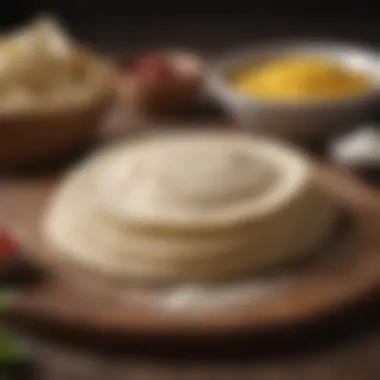
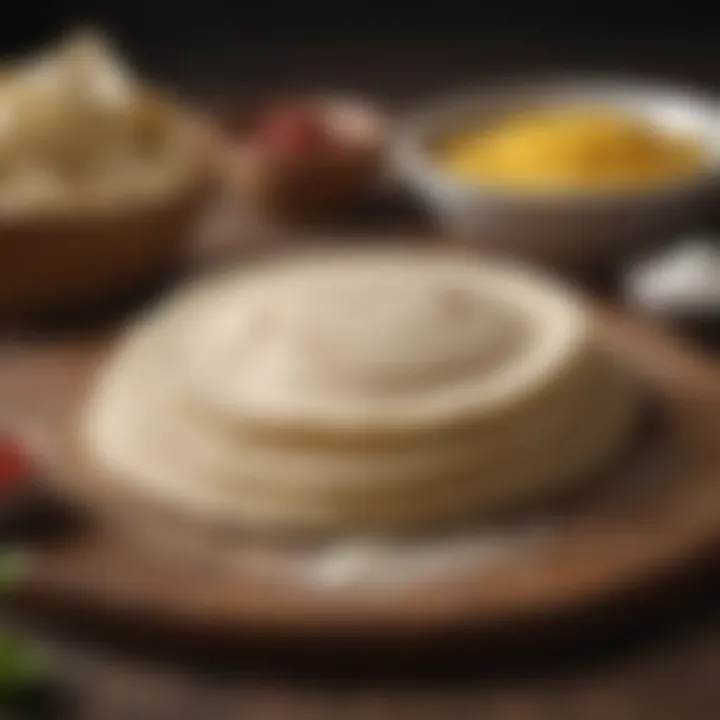
Intro
Making flour tortillas from scratch is not an everyday task for many home cooks. However, this art of creating soft, tasty tortillas brings immense satisfaction and enhances various meals. Knowing how to prepare flour tortillas allows cooks to step up from store-bought variations that may lack quality and authenticity.
This guide dives into the essential steps, ingredients, and techniques involved in making flour tortillas. It offers tips to bring out the best in your creations while addressing common pitfalls and suggestions for enhancement. Mastering the skill of making your own tortillas provides a deeper appreciation for the unassuming staple that plays an important role in numerous culinary traditions.
Recipe Highlight
Introducing the Homemade Flour Tortillas. This recipe promises to produce soft and pliable tortillas that can elevate any meal, from tacos to quesadillas.
Essential Ingredients
- 2 cups all-purpose flour
- 1/2 teaspoon baking powder
- 1/2 teaspoon salt
- 2 tablespoons vegetable oil or lard
- 3/4 cup warm water
Preparation Time
- Estimated Time: 1 hour
Servings
- Yields about 8 tortillas
Step-by-Step Instructions
To create delightful flour tortillas, follow these clear and practical steps:
- Mix Dry Ingredients: In a large mixing bowl, combine the all-purpose flour, baking powder, and salt thoroughly, stirring to distribute the dry ingredients evenly.
- Add Wet Ingredients: Measure accurate 2 tablespoons of vegetable oil or lard, adding it into the flour mixture. Use your fingers to mix until the texture is crumbly.
- Form Dough: Slowly pour in the warm water. Begin mixing with your hand or a spoon, turning the mixture until a cohesive dough forms.
- Knead: On a lightly floured surface, knead the dough for about 5 minutes until smooth. This step creates elasticity in the tortilla.
- Rest: After kneading, cover the dough with a clean kitchen towel and let it rest for 15-30 minutes.
- Roll Out: Divide the dough into equal pieces. Take one piece, flatten it with your hand, and roll it out with a rolling pin until it reaches your desired thickness.
- Cook: Preheat a skillet or griddle over medium-high heat. Place the tortilla onto the hot surface. Cook for 30-45 seconds until bubbles form on the surface, then flip and brown the other side for the same time.
- Store: Keep your cooked tortillas warm by stacking them in a clean towel. This softens them further while cooling. Repeat for the remaining pieces.
- Tip: Aim for a thickness of about 1/8 inch for the best texture.
- In owner of avoid burning, keep an eye on the tortillas.
Variations and Substitutions
Creating flour tortillas is versatile. Here are a few alternative paths:
- Whole Wheat Tortillas: Substitute half or full all-purpose flour with whole wheat flour for an added health benefit.
- Adding Flavors: For delicious variations, integrate spices or herbs like garlic powder or dried chili flakes into the flour.
- Enjoying Tortillas: Serve these tortillas with a range of sides like refried beans, guacamole, or as wraps for hearty fillings.
Time-Saving Cooking Tips
To maximize efficiency in the kitchen, consider the following tips:
- Pre-pare Ingredients: Measure and organize all ingredients ahead of time. This can save you from scrambling in the heat of cooking.
- Tools to Use: A tortilla press can enhance consistency in thickness and speed if frequently preparing tortillas.
- Batch Cooking: Consider making multiple batches at once to enjoy fresh tortillas throughout the week.
Nutritional Information
Homemade flour tortillas are more than just a side dish. Here’s a breakdown:
- Calories: Approximately 140 calories per tortilla.
- Key Nutrients: Contains carbohydrate energy, about 3 grams of protein, and minimal sugars.
These tortillas fit various dietary plans, providing a wonderful gluten option or simply enhancing personal cooking.
The act of creating flour tortillas from scratch not only nourishes the body, but also the soul, contributing to culinary skills that are rich in tradition.
Prelude
Making flour tortillas from scratch is not just a culinary exercise; it is an act that embodies culture and tradition. Flour tortillas are versatile staples in many households, used in a variety of dishes from tacos to wraps. Understanding their significance extends beyond their uses; it ties into appreciating the intricacies of food preparation, the pleasure of creating with one’s own hands, and the enjoyment of a fresher taste that store-bought alternatives cannot replicate.
Importance of Flour Tortillas
Flour tortillas serve as an essential base in numerous cuisines, particularly in Mexican and Tex-Mex dishes. Their soft texture and mild flavor make them adaptable, whether you are wrapping up savory fillings for burritos, serving alongside enchiladas, or enjoying them simply with butter or dips. Moreover, learning how to create them offers personal satisfaction and enables individuals to customize ingredients according to their dietary preferences or restrictions.
Homemade flour tortillas often result in a significant taste improvement. The fresh flavor, coupled with the delightful chewiness, transforms any meal into an enjoyable experience. This artisanal process embraces the essence of cooking—empowering one to craft an authentic item without reliance on preservative-laden store varieties.
Overview of the Process
Creating flour tortillas revolves around some basic yet critical steps. The manner in which each component is handled can significantly affect the final product. First, one must select quality ingredients. This selection includes choosing the most suitable type of flour, determining the right fat, and using clean, temperate water.
Once the ingredients have been assembled, preparing the dough is the next pivotal action. This involves mixing the dry ingredients, incorporating the fat for moisture and flavor, and finally, adding the water skillfully.
Kneading is a crucial process that contributes to the texture of the tortillas. Adequate resting time allows the dough to relax, improving the elasticity during shaping.
After preparing the dough, it’s necessary to follow specific shaping techniques. Rolling the dough evenly ensures uniform thickness which allows for a more consistent cooking surface.
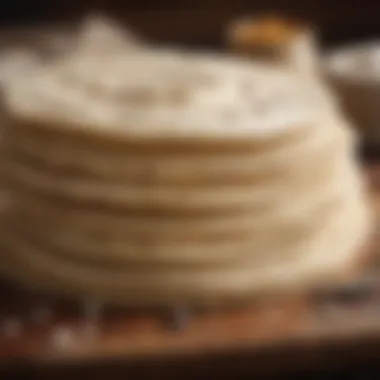
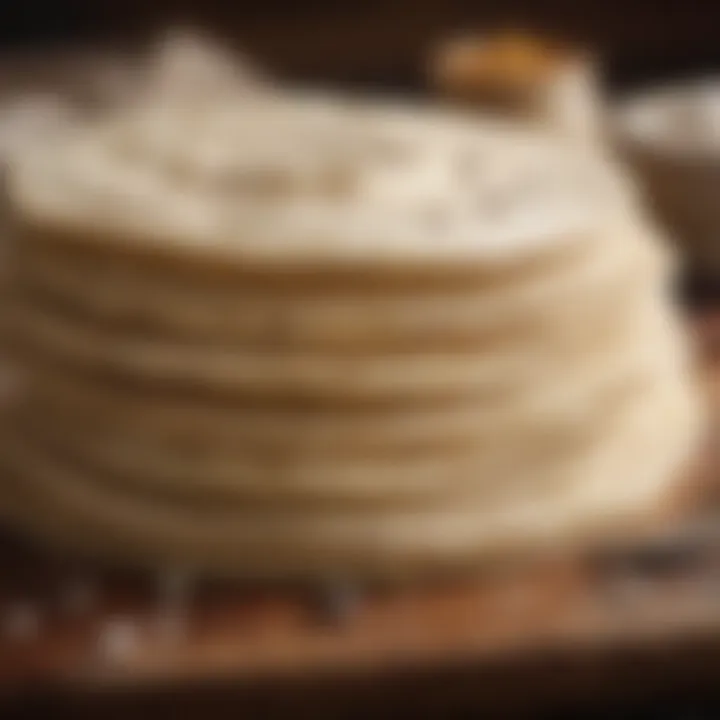
Once shaped, various cooking methods can be applied. Using a hot skillet or griddle will create the lovely, characteristic charred marks that elevate the tortilla's visual appeal and taste.
Ultimately, knowledge of these several stages culminates in the development of essential flour tortillas. Each independent step is vital in achieving the renowned quality found in homemade creations.
Essential Ingredients
The success of homemade flour tortillas heavily relies on selecting the right essential ingredients. Each component in the tortilla-making process plays a critical role, impacting the texture, flavor, and overall quality of the end product. Understanding the significance of these ingredients allows one to tailor the tortillas to personal preferences and dietary restrictions.
Choosing the Right Flour
All-Purpose Flour
All-purpose flour is a staple used in many kitchens and is widely regarded for its versatility. Its protein content typically ranges from 10% to 12%, which provides a good balance for making tortillas. This level of gluten formation allows for a pliable dough that rolls out easily without tearing. The main advantage of using all-purpose flour is its convenience and availability.
However, all-purpose flour might not offer the same depth of flavor that specialized flours provide. Home cooks must consider how this might affect the tortillas they wish to make. Still, for many, the reliable quality of all-purpose flour makes it a go-to choice, ensuring that the result is both consistent and acceptable for numerous dishes.
Alternative Flours
Alternative flours, including whole wheat flour, corn flour, and rice flour, can offer unique flavor profiles and nutritional benefits. Whole wheat flour, for example, contains more fiber and varies the taste and texture by imparting a nuttier flavor. This can be greatly advantageous for those who are seeking healthier options.
The downside is that these flours may yield a denser tortilla, which might not suit everyone's missed preferences. Knowledge about hydration adjustments is essential when substituting other flours, as they absorb water differently than all-purpose flour tends to do.
The Role of Fat
Fat is an understated player in the tortilla realm. Incorporating a source of fat enhances the texture and flavor of the tortillas, making them more tender.
Butter
Using butter as the fat option comes with distinct advantages. It delivers a rich flavor and contributes to the flakiness of the tortillas. Butter's incorporation into the tortilla dough will yield results that are both delicious and appealing to many palates. However, some might find working with butter a bit cumbersome due to its temperature sensitivity—if it gets too warm, achieving the right consistency can be challenging.
Lard
Lard is a traditional fat used in many authentic tortilla recipes. It delivers an exceptional taste and improves the dough's elasticity, contributing to perfectly pliable tortillas. Many aficionados argue that lard makes the best tortilla because of its unique flavor. But it comes with dietary considerations as it contains saturated fat, prompting some cooks to seek other options.
Vegetable Oil
Vegetable oil is another common fat choice, lauded for its neutral flavor. It is also appealing unto those opting for a plant-based solution or those wishing to avoid animal fats.
However, oil won’t provide the same level of flakiness as butter or lard, which potential tortilla makers need to weigh as they consider their options.
Water Quality and Temperature
Water is a fundamental part of the tortilla-making process. It hydrates and binds the flour, crucial for dough development. Using high-quality water ensures that there are no unwanted minerals or contaminants present.
Moreover, temperature plays an important role; using warm water can make the gluten develop more thoroughly, resulting in a softer and more elastic dough. Therefore, the quality and temperature of water cannot be overlooked.
Salt: Not Just for Flavor
Salt serves two primary functions: it enhances flavor and strengthens gluten. It helps to control fermentation by regulating yeast activity, which can indirectly affect the texture of the tortilla. Proper seasoning prevents the dough from being bland and makes a significant qualitative difference. While often considered optional, a good pinch of salt adds to the overall enjoyment of the tortillas.
Preparation Steps
Preparation steps are crucial in the process of making flour tortillas from scratch. Each stage contributes uniquely to the end product, primarily focusing on texture and flavor. Preparation not only aids in achieving the desired consistency but also enhances the tortilla's final taste. Understanding these steps helps prevent common mistakes that can lead to inferior tortillas.
Mixing the Dough
Dry Ingredients
The first step in mixing dough is selecting the dry ingredients. The primary dry ingredient used is flour, which determines the whole texture of the tortillas. The most common choice is all-purpose flour due to its versatility. It creates a soft and pliable dough which is sought after when making tortillas. One unique feature of this type of flour is its gluten composition. Gluten gives the flour structure and elasticity. This characteristic is beneficial as it helps the tortilla hold together when cooked and filled. However, a disadvantage with too much gluten is that it can yield a tougher tortilla if improperly mixed or rolled.
Adding Fats
Introducing fats into the dough is the next key step. Fats such as butter, lard, or vegetable oil enrich the dough, resulting in a softer texture. Each type of fat introduces its flavor and denser texture, offering cooks a choice in characterizing their tortillas. For instance, lard is a traditional choice, adding a rich taste. Its unique feature lies in its composition, which makes it beneficial for creating a tender tortilla without overly drying out. However, some may choose to avoid animal fats for dietary reasons, making vegetable oil a practical alternative, albeit with a lighter mouthfeel.
Incorporating Water
The final part of the dough-mixing phase involves adding water. The right amount of water hydrates the dry ingredients, facilitating gluten formation. Water acts as a binder, ensuring that the ingredients hold together effectively. It’s critical to note that the quality of water used can impact the dough. Water that is too cold may hinder the dough's ability to hydrate properly, which can affect the final texture. Conversely, excessive water can make it overly sticky, making the process more challenging. This careful balance is vital for ensuring the tortilla dough maintains the perfect consistency.
Kneading Techniques
After mixing the ingredients, kneading is essential. This step develops gluten, which contributes to the dough’s elasticity and strength. During kneading, it is important to apply even pressure, particularly focusing on folding and pressing to build up the necessary texture. Over-kneading can lead to tough tortillas. Keeping the kneading process moderate helps achieve a light and tender finish in the tortillas when cooked.
Resting the Dough
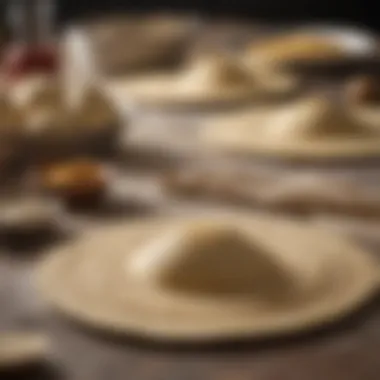
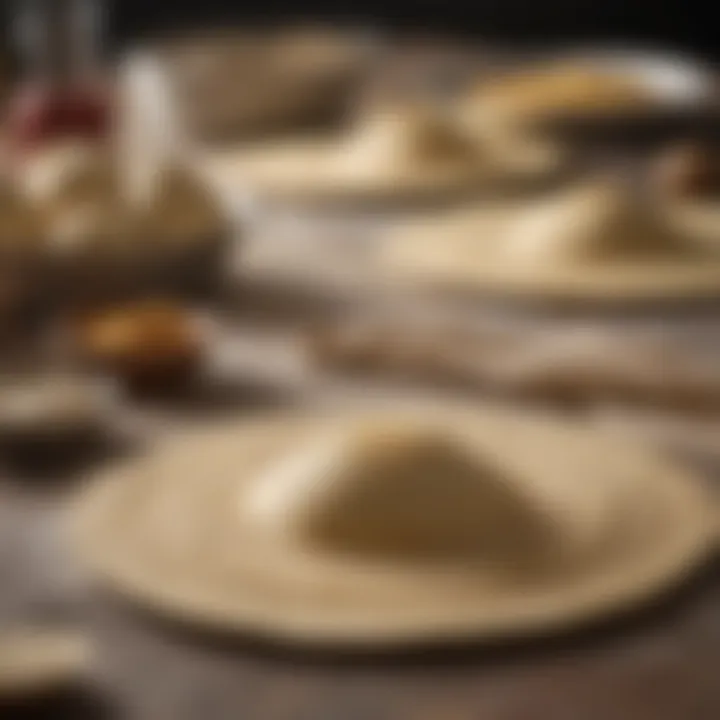
Resting the dough is arguably one of the most important steps not to overlook. It empowers the dough to relax, further enhancing the structural integrity of the finished tortillas.
Benefits of Resting
A primary benefit of resting is improved texture. When the dough rests, gluten relaxes, preventing the tortillas from springing back when rolled out. This characteristic (which some may misjudge as minor) significantly affects ease and effectiveness during shaping. In essence, allowing the dough to rest provides a softer, more workable result.
Time Recommendations
Time recommendations for resting dough usually range from 20 minutes to an hour. While some recipes suggest longer rests for optimum outcomes, shorter durations can also yield satisfactory results. However, it is essential to differentiate between the type of flour and desired tortilla characteristics, as this affects resting time. Overall, it’s a small investment of time for a better-tasting product.
Shaping the Tortillas
Shaping the tortillas is a crucial stage in the process of making flour tortillas from scratch. This phase influences the texture and appearance of the final product. Properly shaped tortillas ensure even cooking, which allows them to retain moisture and flexibility, essential features for their usability in various dishes. If shaping is neglected or done incorrectly, the tortillas may turn out uneven and more challenging to fold or wrap, impacting the overall experience. Therefore, clarity in this section is vital to successfully mastering this culinary skill.
Dividing the Dough
Before you can shape the tortillas, it's important to divide the dough evenly. This step ensures consistency in size and cooking time. The dough should be rested adequately before this division to enhance its elasticity. You can use a kitchen scale to portion the dough accurately, aiming for pieces around 60 to 100 grams depending on desired tortilla size. This method allows you to maintain uniformity, helping to achieve an even cook and appealing presentation.
Rolling Techniques
Using a Rolling Pin
Using a rolling pin to flatten the dough is a common and effective method for shaping tortillas. The main aspect of this technique is its ability to create thin, consistent discs of dough, crucial for even cooking. A rolling pin allows for control over the thickness. The typical characteristic of using this tool is its range in length and materials. Many prefer wooden rolling pins as they often provide a balance between weight and grip.
The biggest benefit of the rolling pin is the efficiency it offers. You can roll out multiple tortillas in a relatively short span, making the process quicker. However, one consideration is that some may lack the precision in size and shape initially compared to their preferred method. Yet with practice, this technique can lead any aspiring chef to master tortillas with ease and finesse.
Alternatives to Rolling Pins
Alternatives to rolling pins can also prove useful, particularly to those who prefer a diverse toolkit in the kitchen. Methods such as pressing the dough between two plates or using a flat bottom skillet provide features that aligns with casual cooking practices. Their main attribute is accessibility; almost every home has a flat surface handy.
However, the rolling pin’s advantage in achieving a consistent thinness sets it apart. While alternatives are generally quicker for immediate shaping, they may lead to uneven thickness, which could impact even cooking. Therefore, while these options might serve in a pinch, they can't consistently match the reliability of a rolling pin in this specific endeavor.
Always remember, the method you choose for shaping the tortillas can affect the cooking outcome significantly. Experiment to discover which technique suits your style the best.
Cooking Methods
Cooking methods play a crucial role in the process of making flour tortillas from scratch. Different approaches impact the final texture, flavor, and even the nutritional qualities of the tortillas. Understanding how to choose the right cooking method ensures that the tortillas cook evenly and develop a desired level of char and tenderness. Two popular cooking options are the skillet and the griddle, each contributing unique benefits to the final outcome of the tortillas.
Using a Skillet
Using a skillet is often a preferred method for cooking flour tortillas due to its accessibility and ease of use in home kitchens. A well-chosen skillet can result in perfectly cooked tortillas with consistent heat.
Pan Selection
The selection of the pan can directly influence the cooking performance. Cast iron skillets are especially favored for their heat retention and even heating. They offer a rustic quality to tortillas that complements traditional flavors. Another characteristic of a non-stick skillet is the ease with which tortillas can be flipped and removed once cooked. However, non-stick pans may not give the same degree of browning as the cast iron. It's best to consider both heat consistency and ease of use when selecting a pan for this purpose.
Temperature Control
Temperature control is critical when it comes to cooking flour tortillas. Ideal temperature settings allow the tortilla to puff while avoiding burnt edges. It is often recommended to preheat the skillet until it reaches a high enough temperature—around 400 to 450 degrees Fahrenheit. This helps to form a suitable texture and browning, which enhances flavor. A unique feature about proper temperature management is that it reduces the cooking time, allowing more controlled results.
Using a Griddle
A griddle provides a larger cooking surface, which can be an advantage when preparing multiple tortillas at once. Griddles maintain steady heat across their surface area. This consistency aids in achieving an even cooking across flour tortillas, making it easy to prepare several tortillas without the need to continually adjust heat and pan positioning. Larger batches can promote gathering and serving for family-style meals.
Testing for Doneness
Evaluating whether tortillas are properly cooked necessitates some vigilance. They should appear lightly browned with visible puffing from the steam building within. A practical method for testing doneness includes gently pressing the circumference of each tortilla with a spatula. If it springs back, it is likely done; if it remains indented, it may require more time in the skillet or griddle. Understanding this subtle yet important aspect can greatly improve the end results of homemade flour tortillas.
Remember: the perfectly cooked tortilla should be soft yet firm, ready to hold whatever delights you prepare to fill them with.
Storage and Preservation
Storing and preserving your homemade flour tortillas is essential to maintaining their freshness and quality. After spending time creating these delicate discs, you want to ensure they stay soft and pliable for future use. Proper storage will allow you to enjoy homemade tortillas well into the future, avoiding waste and enhancing your culinary flexibility.
Short-Term Storage
For short-term storage of flour tortillas, the method you choose depends on how quickly you intend to consume them. If you plan to use them within a day or two, stacking them in a container is practical. Place parchment paper between the tortillas to prevent them from sticking to each other. Enclosing them in an airtight container helps preserve moisture while keeping them from drying out.
A resealable plastic bag also can be effective here. However, for a longer freshness period, you might want to consider the refrigeration option. Wrapping the tortillas in plastic wrap or aluminum foil will enhance their lifespan for about a week. Just ensure they're airtight to minimize exposure to air and humidity. When ready to use, a short time on a skillet can rejuvenate their texture, making them almost like fresh again.
Long-Term Freezing Techniques
If you have made a large batch and wish to store flour tortillas for an extended period, freezing is your best option. Not only does freezing maintain their taste and texture, but it can also save you time in the kitchen on busy days. The freezing process involves several steps:


- Preparation: Ensure the tortillas are completely cooled before freezing, as wrapping them while warm can lead to undesirable moisture.
- Spacing: To prevent sticking, lay parchment paper between each tortilla. This allows for easy separation, so you can take only what you need without the hassle of thawing all.
- Wrap: Place the stack in either a high-quality freezer bag or wrap it tightly in plastic wrap. Depending on your preference, you can exclude excess air from the bag to reduce freezer burn, which can compromise flavor.
- Label: Always label the bag with the date of freezing. While they can last several weeks, consumption within two months is recommended to enjoy them at their best quality.
When ready to use frozen tortillas, simply remove them and allow them to thaw either in the fridge overnight or at room temperature for a few hours. Alternatively, microwaving with a damp cloth can revitalize some moisture quite fast.
Proper storage practices for homemade flour tortillas drastically enhance enjoyment in meals.
Ultimately, the choice between short-term or long-term storage of flour tortillas will depend on your usage plans. Keep in mind, each storage method has its advantages, and tailoring your approach gives you the best outcome for your homemade creations.
Serving Suggestions
Serving suggestions are essential for highlighting the versatility of flour tortillas. Beyond mere transportation for various fillings, tortillas can elevate meals through strategic pairings. Including accompaniments enhances complexity and adds a flavorful element. Neglecting this aspect may lead to missed opportunities for taste exploration.
Accompaniments
Salsas and Dips
Salsas and dips play a crucial role in complementing flour tortillas. They infuse flavors that can transform a simple tortilla into an exquisite experience. Various salsa options—from pico de gallo to roasted tomatillo salsa—showcase distinct flavor profiles, often meanwhile balanced by various textures.
A key characteristic of salsas is their adaptability. They can be adjusted for spice levels and ingredients, reflecting seasonal produce. This flexibility makes them a popular choice for many. Their fresh, zesty elements engage the palate and can enhance the enjoyment of each bite of the tortilla.
The unique feature of salsas is that they can be prepared ahead of time. This allows for convenience during gatherings or meal preparations. However, one disadvantage could be that some salsa varieties may not hold up well if made too far in advance, often losing their vibrancy.
Fillings and Toppings
Fillings and toppings introduce substantial variety to the use of tortillas. They offer diverse combinations that integrate flavors and textures ranging from savory to spicy, to fresh. Incorporating items like grilled chicken, sautéed vegetables, or braised beef creates heartier meals.
Fillings can also be customized based on dietary preferences. For instance, vegetarian or vegan filling options can easily be accommodated without sacrificing taste. This characteristic makes fillings a beneficial add-on, emphasizing inclusivity in meal preparation.
However, while filling tortillas can be convenient, care must be taken to not overfill. Overfilling can lead to messiness and complicate the eating experience.Here, balance is essential to maintain both flavor and practicality.
Pairing with Other Dishes
Pairing flour tortillas with other dishes opens up further culinary possibilities. Consider the textures and flavors of rice, beans, or sautéed greens coming together with tortillas. It rounds out meals in a balanced way, creating an inviting environment suited for any occasion.
Effective pairings highlight regional tastes. For example, simple grilled meats, accompanied by sides such as guacamole or corn salad, complements the tortila base quite nicely. Fade of flavors can gain prominence from these interactions, achieving a greater overall harmony.
Common Pitfalls
Understanding common pitfalls in making flour tortillas is crucial for achieving success. Many cooks, whether novices or experienced, tend to run into the same mistakes that can compromise the quality of their tortillas. By identifying and recognizing these pitfalls, you can navigate the process more effectively and produce tortillas that are not only functional but also delicious. Addressing these common issues will enhance your skill set and strengthen your appreciation for this essential recipe.
Overworking the Dough
Overworking the dough is often an unintentional mistake for many. It can happen when too much kneading takes place. This might seem harmless, but it profoundly affects the texture of the final product. When dough is overworked, gluten develops excessively. This leads to a tough tortilla rather than the soft, pliable one you desire. The basic rule is simple: knead the dough until it is smooth and cohesive, typically around one to two minutes. It should be elastic yet soft, providing just enough resistance without feeling hard or stiff. If you observe the texture is starting to feel too firm or elastic, stop kneading.
Tips to Avoid Overworking
- Knead Lightly: Aim for the right balance in mixing and kneading without becoming too vigorous.
- Set a Timer: Time your kneading to encourage consistency.
- Monitor Texture: Pay attention to how the dough feels; it should remain soft and gentle.
Embracing these practices will ensure that your dough retains the right consistency, paving the way for tortillas with the correct texture.
Incorrect Cooking Temperature
The temperature at which you cook flour tortillas holds significant influence over their overall quality. Failing to find the right cooking temperature can lead to a range of undesirable outcomes. Cooking at too low a temperature can result in tortillas that are pale and lack the enticing flavor from browning. Conversely, going too high can create burnt surfaces, while leaving the insides undercooked.
The ideal cooking temperature is typically around medium to medium-high heat. You will create effective browning while also achieving a properly cooked interior. A preheated skillet or griddle is essential as it provides an even cooking surface.
Signs of Correct Temperature
- Even Light Brown: Look for even, light brown spots on the tortilla when flipped.
- Steady Sizzle: On making contact with the cooking surface, listen for a satisfying sizzle.
- Soft Texture: Once the tortillas are cooked properly, they should feel soft and pliable.
Correctly controlling the cooking temperature ensures that each tortilla is adequately cooked, enhancing both taste and texture.
Becoming mindful of these common pitfalls transforms your tortilla-making endeavor from challenging to gratifying, empowering your culinary progress.
Epilogue
In this article, we have explored the various facets of making flour tortillas from scratch. Mastering this skill is essential for anyone who values authentic Mexican cuisine and desires to elevate their cooking repertoire.
Recap of Key Points
We covered the entire process from selecting the right ingredients to specific cooking techniques. Key elements included:
- Essential Ingredients: Understanding the importance of flour, fat, water, and salt.
- Preparation Steps: Effective methods for mixing, kneading, and resting dough.
- Shaping and Cooking: Techniques for seamlessly shaping tortillas and cooking them to perfection.
- Common Pitfalls: Avoiding errors that often lead to less-than-ideal results.
- Storage and Serving: Best practices for storage and complementary dishes.
A comprehensive grasp of these points ensures that readers can feel confident in their ability to create delicious, homemade flour tortillas.
"Experimenting with flour tortillas opens avenues for culinary creativity and personal preference."
Encouragement for Continued Experimentation
As you venture into making flour tortillas, remember that each attempt can lead to improvement and joy in the kitchen. Experimenting with different flours, fats, or additional flavorings can yield unique results. Do not shy away from tests; sometimes the perfect tortilla is created through trial and observation. The more you practice, the more natural theprocess will become, reinforcing both your skills and pleasure in cooking.
This journey from mixing flour, to rolling out perfect tortillas ultimately enhances not only your meals but your understanding of cooking as an art. Once you feel comfortable, consider integrating changes—such as incorporating herbs or seasonings—to suit your taste or innovate your family recipes.







